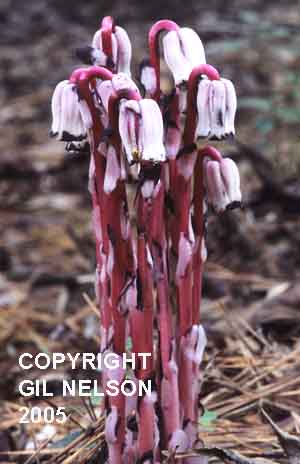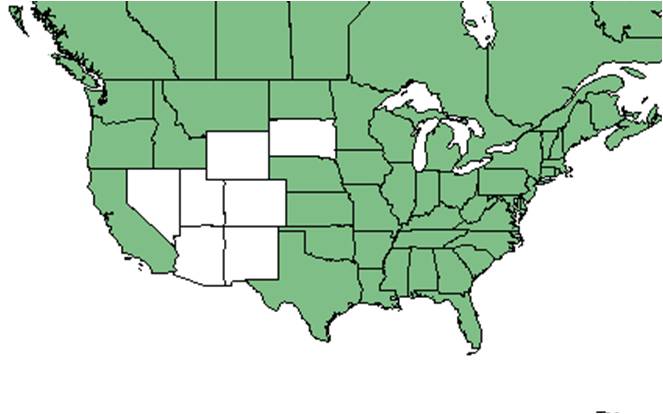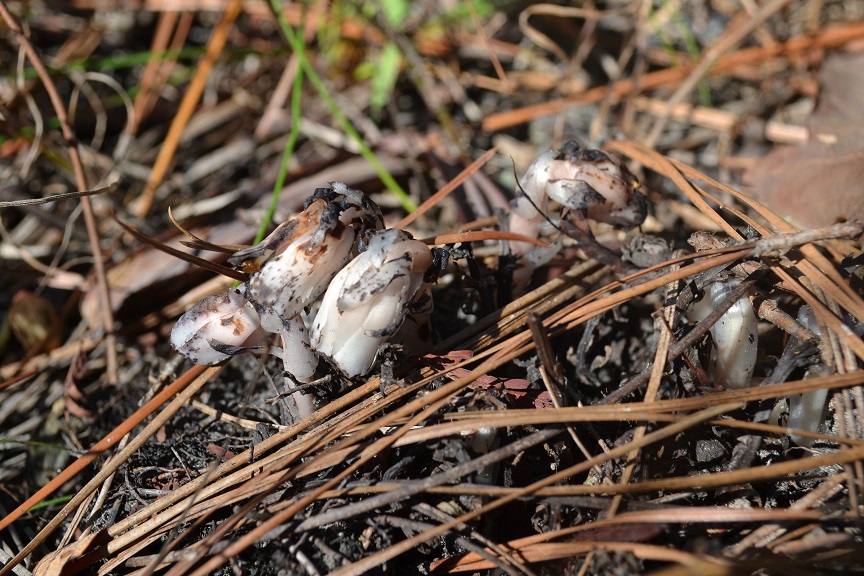Difference between revisions of "Monotropa uniflora"
(→Seed dispersal) |
Emmazeitler (talk | contribs) |
||
| Line 18: | Line 18: | ||
}} | }} | ||
| − | Common name: Indian pipes | + | Common name: Indian pipes<ref name="weakley">Weakley, A.S. 2015. Flora of the southern and mid-atlantic states. Working Draft of 21 May 2015. University of North Carolina at Chapel Hill, Chapel Hill, North Carolina.</ref> |
==Taxonomic notes== | ==Taxonomic notes== | ||
| − | + | Synonyms: ''Monotropa brittonii'' Small.<ref name="weakley">Weakley, A.S. 2015. Flora of the southern and mid-atlantic states. Working Draft of 21 May 2015. University of North Carolina at Chapel Hill, Chapel Hill, North Carolina.</ref> | |
| + | |||
| + | Varieties: none.<ref name="weakley">Weakley, A.S. 2015. Flora of the southern and mid-atlantic states. Working Draft of 21 May 2015. University of North Carolina at Chapel Hill, Chapel Hill, North Carolina.</ref> | ||
==Description== | ==Description== | ||
| Line 26: | Line 28: | ||
A description of ''Monotropa uniflora'' is provided in [http://efloras.org/florataxon.aspx?flora_id=1&taxon_id=200016137 The Flora of North America]. | A description of ''Monotropa uniflora'' is provided in [http://efloras.org/florataxon.aspx?flora_id=1&taxon_id=200016137 The Flora of North America]. | ||
| + | ''M. unitropa'' has a glabrous stem and solitary flower, with white coloration when fresh and black as it ages.<ref name="weakley">Weakley, A.S. 2015. Flora of the southern and mid-atlantic states. Working Draft of 21 May 2015. University of North Carolina at Chapel Hill, Chapel Hill, North Carolina.</ref> | ||
==Distribution== | ==Distribution== | ||
| + | This plant ranges from Labrador and Alaska, south to southern Florida, Texas, and California. There are disjunct populations in southern Mexico, Central America, South America, and eastern Asia.<ref name="weakley">Weakley, A.S. 2015. Flora of the southern and mid-atlantic states. Working Draft of 21 May 2015. University of North Carolina at Chapel Hill, Chapel Hill, North Carolina.</ref> | ||
==Ecology== | ==Ecology== | ||
===Habitat=== <!--Natural communities, human disturbed habitats, topography, hydrology, soils, light, fire regime requirements for removal of competition, etc.--> | ===Habitat=== <!--Natural communities, human disturbed habitats, topography, hydrology, soils, light, fire regime requirements for removal of competition, etc.--> | ||
| − | This species can be found in mixed woodlands, mesic bluffs, ravine edges, along swamps, pine scrub, and hardwood hammock edges. <ref name="FSU Herbarium">Florida State University Robert K. Godfrey Herbarium database. URL: [http://herbarium.bio.fsu.edu http://herbarium.bio.fsu.edu]. Last accessed: June 2014. Collectors: Loran C. Anderson, Herbert Kessler, Jacob Kimel, R.K. Godfrey, John B. Nelson, George R. Cooley, D. B. Ward, J. Beckner, Lovett E. Williams, Michael Castagna, Travis MacClendon, K. MacClendon, P. Howell, B. Thomas, G. Wilder, R. Komarek, Kathleen Brady, Ed Keppner, and Lisa Keppner. States and Counties: Florida: Bay, Calhoun, Gadsden, Hernando, Leon, Liberty, Marion, and Wakulla. Georgia: Grady.</ref> Observed growing in shaded areas, ''M. uniflora'' occurs in moist and dry sand, sandy loam, and rich hummus. <ref name="FSU Herbarium"/> It is also found in human discturbed habitats such as hiking trails, residential backyards, and front lawns. <ref name="FSU Herbarium"/> Associates species include ''Carya, Magnolia, Quercus, Habernaria quinqueseta, Cypress, Burmannia biflora, Pinus clausa, Quercus myrtifolia,'' and ''Q. maritima''. <ref name="FSU Herbarium"/> | + | This species can be found in mixed woodlands, mesic bluffs, ravine edges, along swamps, pine scrub, and hardwood hammock edges.<ref name="FSU Herbarium">Florida State University Robert K. Godfrey Herbarium database. URL: [http://herbarium.bio.fsu.edu http://herbarium.bio.fsu.edu]. Last accessed: June 2014. Collectors: Loran C. Anderson, Herbert Kessler, Jacob Kimel, R.K. Godfrey, John B. Nelson, George R. Cooley, D. B. Ward, J. Beckner, Lovett E. Williams, Michael Castagna, Travis MacClendon, K. MacClendon, P. Howell, B. Thomas, G. Wilder, R. Komarek, Kathleen Brady, Ed Keppner, and Lisa Keppner. States and Counties: Florida: Bay, Calhoun, Gadsden, Hernando, Leon, Liberty, Marion, and Wakulla. Georgia: Grady.</ref> Observed growing in shaded areas, ''M. uniflora'' occurs in moist and dry sand, sandy loam, and rich hummus.<ref name="FSU Herbarium"/> It is also found in human discturbed habitats such as hiking trails, residential backyards, and front lawns.<ref name="FSU Herbarium"/> Associates species include ''Carya, Magnolia, Quercus, Habernaria quinqueseta, Cypress, Burmannia biflora, Pinus clausa, Quercus myrtifolia,'' and ''Q. maritima''.<ref name="FSU Herbarium"/> |
===Phenology=== <!--Timing off flowering, fruiting, seed dispersal, and environmental triggers. Cite PanFlora website if appropriate: http://www.gilnelson.com/PanFlora/ --> | ===Phenology=== <!--Timing off flowering, fruiting, seed dispersal, and environmental triggers. Cite PanFlora website if appropriate: http://www.gilnelson.com/PanFlora/ --> | ||
| − | This species | + | This species flowers from June through October and fruits from August through November.<ref name="weakley">Weakley, A.S. 2015. Flora of the southern and mid-atlantic states. Working Draft of 21 May 2015. University of North Carolina at Chapel Hill, Chapel Hill, North Carolina.</ref> |
===Seed dispersal=== | ===Seed dispersal=== | ||
| − | This species is thought to be dispersed by gravity. <ref>Kirkman, L. Katherine. Unpublished database of seed dispersal mode of plants found in Coastal Plain longleaf pine-grasslands of the Jones Ecological Research Center, Georgia.</ref> | + | This species is thought to be dispersed by gravity.<ref>Kirkman, L. Katherine. Unpublished database of seed dispersal mode of plants found in Coastal Plain longleaf pine-grasslands of the Jones Ecological Research Center, Georgia.</ref> |
<!--===Seed bank and germination===--> | <!--===Seed bank and germination===--> | ||
<!--===Fire ecology===--> <!--Fire tolerance, fire dependence, adaptive fire responses--> | <!--===Fire ecology===--> <!--Fire tolerance, fire dependence, adaptive fire responses--> | ||
Revision as of 14:07, 28 September 2020
| Monotropa uniflora | |
|---|---|

| |
| Photo was taken by Gil Nelson | |
| Scientific classification | |
| Kingdom: | Plantae |
| Division: | Magnoliophyta - Flowering plants |
| Class: | Magnoliopsida – Dicotyledons |
| Order: | Ericales |
| Family: | Monotropaceae |
| Genus: | Monotropa |
| Species: | M. uniflora |
| Binomial name | |
| Monotropa uniflora L. | |

| |
| Natural range of Monotropa uniflora from USDA NRCS Plants Database. | |
Common name: Indian pipes[1]
Contents
Taxonomic notes
Synonyms: Monotropa brittonii Small.[1]
Varieties: none.[1]
Description
A description of Monotropa uniflora is provided in The Flora of North America.
M. unitropa has a glabrous stem and solitary flower, with white coloration when fresh and black as it ages.[1]
Distribution
This plant ranges from Labrador and Alaska, south to southern Florida, Texas, and California. There are disjunct populations in southern Mexico, Central America, South America, and eastern Asia.[1]
Ecology
Habitat
This species can be found in mixed woodlands, mesic bluffs, ravine edges, along swamps, pine scrub, and hardwood hammock edges.[2] Observed growing in shaded areas, M. uniflora occurs in moist and dry sand, sandy loam, and rich hummus.[2] It is also found in human discturbed habitats such as hiking trails, residential backyards, and front lawns.[2] Associates species include Carya, Magnolia, Quercus, Habernaria quinqueseta, Cypress, Burmannia biflora, Pinus clausa, Quercus myrtifolia, and Q. maritima.[2]
Phenology
This species flowers from June through October and fruits from August through November.[1]
Seed dispersal
This species is thought to be dispersed by gravity.[3]
Conservation and management
Cultivation and restoration
Photo Gallery
References and notes
- ↑ 1.0 1.1 1.2 1.3 1.4 1.5 Weakley, A.S. 2015. Flora of the southern and mid-atlantic states. Working Draft of 21 May 2015. University of North Carolina at Chapel Hill, Chapel Hill, North Carolina.
- ↑ 2.0 2.1 2.2 2.3 Florida State University Robert K. Godfrey Herbarium database. URL: http://herbarium.bio.fsu.edu. Last accessed: June 2014. Collectors: Loran C. Anderson, Herbert Kessler, Jacob Kimel, R.K. Godfrey, John B. Nelson, George R. Cooley, D. B. Ward, J. Beckner, Lovett E. Williams, Michael Castagna, Travis MacClendon, K. MacClendon, P. Howell, B. Thomas, G. Wilder, R. Komarek, Kathleen Brady, Ed Keppner, and Lisa Keppner. States and Counties: Florida: Bay, Calhoun, Gadsden, Hernando, Leon, Liberty, Marion, and Wakulla. Georgia: Grady.
- ↑ Kirkman, L. Katherine. Unpublished database of seed dispersal mode of plants found in Coastal Plain longleaf pine-grasslands of the Jones Ecological Research Center, Georgia.
